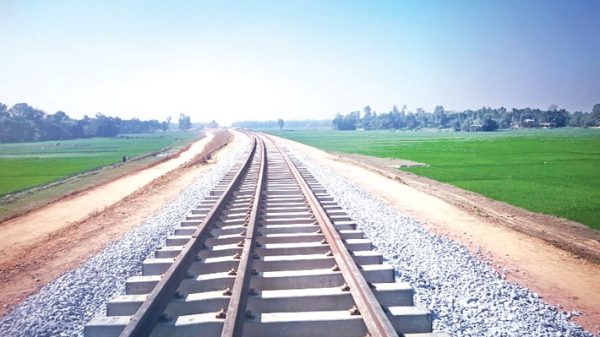Ctg-Cox’s Bazar train service from September

- Update Time : Monday, July 10, 2023
- 54 Time View

CHATTOGRAM: The eagerly anticipated construction of the Chattogram (Dohazari)-Cox’s Bazar rail line has moved into high gear, as Bangladesh Railway (BR) aims to have the tracks operational by September this year.
Project Director Md Mofizur Rahman reported that 86 percent of the physical works are now completed, with 82 kilometres of the 100-kilometre track from Dohazari to Cox’s Bazar already in place.
Additional manpower has been deployed after the Eid vacation to accelerate progress towards the target deadline.
The original plan was to launch the rail route in December this year, however, the Railway Minister’s announcement of an earlier start in September necessitated an upsurge in work pace.
“We are making every effort to have the stations, equipment and other necessary facilities operational by the deadline,” Rahman stated, acknowledging that some elements will be completed post-launch.
The project, named ‘Construction of Single Line Dual-Gauge Railway Track from Dohazari to Cox’s Bazar Via Ramu and Ramu to Ghumdhum near Myanmar’, is a priority government initiative. Initially slated for completion in June, the ongoing pandemic caused unforeseen delays.
The total railway distance from Chattogram to Cox’s Bazar is approximately 154 kilometres, with an existing 54-kilometre track between Chattogram and Dohazari.
However, the worn-out Kalurghat road-cum-rail bridge and the deteriorating state of the old track present significant obstacles to commencing service on the new route.
The planned replacement of the century-old Kalurghat bridge, a key component of the new Chattogram (Dohazari)-Cox’s Bazar rail line, has yet to commence.
As an interim measure, the Railway has elected to renovate the bridge under the supervision of the Bangladesh University of Engineering and Technology (BUET). Though the renovation was scheduled to start in June, various complexities have delayed the work.
Another proposed project, the establishment of a chord-line from Faujdarhat to Sholoshahar, designed to facilitate travel on the new route, is also still pending.
As a result, passengers travelling between Dhaka and Cox’s Bazar will need an additional hour and a half to change the locomotive’s direction at the Chattogram Railway Station.
Project Director Md Mofizur Rahman confirmed that some aspects of the project would remain incomplete at its September launch.
He expressed optimism that the Kalurghat Bridge and old tracks would pose minimal issues as trains could be navigated through them at reduced speeds.
As for the chord-line, Rahman stated that implementation would follow government directives once the first phase of the project was completed.
Future decisions regarding the project’s second phase, which involves developing a rail track from Ramu to Ghumdhum, will also be deferred.
Currently, the Chattogram-Cox’s Bazar highway serves as the principal connection between the beach city and the rest of the country. However, it struggles to cope with the large influx of tourists and goods transportation to and from Cox’s Bazar.
The railway project aims to address these challenges, ensuring safer, more comfortable, and cheaper transportation for locals and tourists alike, and facilitating the more efficient transport of agricultural goods.
The existing Chattogram-Dohazari metre-gauge line was established based on a survey conducted by Myanmar Railway from 1917 to 1919. Unfortunately, due to World War II, the track was never extended up to Ramu.
Now, a 100 km track from Dohazari to Cox’s Bazar via Ramu will be established in the first phase, followed by a 28 km track from Ramu to Ghumdhum in the second phase.
The first phase also includes the construction of a 39-kilometre loop-line, 39 major bridges, 145 minor bridges and culverts, 96 level crossings, three highway crossings, and nine new stations.
The project, which costs around Tk 18,034 crore, was initiated in 2016, six years after it was first conceived. Funding is being provided by the Government of Bangladesh and the Asian Development Bank, with CREC-Tama JV and CCECC-Max JV serving as project contractors.















